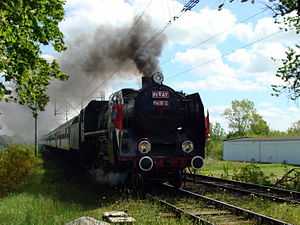PKP class Pm36
| PKP Pm36 | |
|---|---|
|
Pm36-2 (Beautiful Helena) | |
| Type and origin | |
| Power type | Steam |
| Builder | Fablok |
| Build date | 1937 |
| Total produced | 2 |
| Specifications | |
| Configuration | 4-6-2 |
| UIC classification | 2′C1′ h2 |
| Gauge | 1,435 mm (4 ft 8 1⁄2 in) |
| Leading wheel diameter | 950 mm (37.40 in) |
| Driver diameter | 2,000 mm (78.74 in) |
| Trailing wheel diameter | 1,150 mm (45.28 in) |
| Length | 24.843 m (81 ft 6 in) |
| Axle load | 17.2 tonnes (16.9 long tons; 19.0 short tons) |
| Weight on drivers | 51.6 tonnes (50.8 long tons; 56.9 short tons) |
| Locomotive weight | 94.0 tonnes (92.5 long tons; 103.6 short tons) |
| Tender weight | 72.9 tonnes (71.7 long tons; 80.4 short tons) |
| Tender capacity | 9.0 tonnes (8.9 long tons; 9.9 short tons) |
| Boiler pressure | 18 kg/cm2 (1.77 MPa; 256 psi) |
| Firegrate area | 3.85 m2 (41.4 sq ft) |
| Heating surface: – Firebox | 15.00 m2 (161.5 sq ft) |
| – Total | 198.0 m2 (2,131 sq ft) |
| Superheater area | 71.2 m2 (766 sq ft) |
| Cylinders | Two, outside |
| Cylinder size | 530 mm × 700 mm (20.87 in × 27.56 in) |
| Valve gear | Heusinger (Walschaerts) |
| Performance figures | |
| Maximum speed |
Pm36-1: 140 km/h (87 mph) Pm36-2: 130 km/h (81 mph) |
| Power output | 1,325 kW (1,780 hp) |
| Tractive effort | 147.5 kN (33,160 lbf) |
| Locomotive brake | Westinghouse |
| Career | |
| Operator(s) | PKP » DRB » PKP |
| Class |
PKP: Pm36 DRB: 186 |
| Number(s) |
PKP: Pm36-1 to Pm36-2 DRB: 18 601 to 18 601 |
| Nicknames | Piękna Helena |
| Locale | Poland |
| Retired | 1965 |
| Restored | 1995 |
| Current owner | PKP |
PKP class Pm36 is a class of two express passenger (P) 4-6-2 (m) steam locomotives ordered in 1936 for the Polskie Koleje Państwowe (Polish State Railways).
History
Design

The design was ready in 1936 and the following year the first two prototypes were built. One of them (Pm36-1) had aerodynamic fairing. The construction as well as the shape of it was designed by inz. Kazimierz Zembrzuski, head of the design office in the First Polish Factory of Locomitives and at the same time professor of the Warsaw University of Technology. The other (Pm36-2) had a standard look. The idea was to test both engines in parallel to compare top speed, acceleration, coal and water consumption etc. The Pm36-1 won a gold medal at the 1937 International Exposition of Art and Technology in Paris.
Service
After the German occupation of Poland during World War II, the two locomotives were renumbered into the Deutsche Reichsbahn (DRB) fleet as 18 601 and 18 602 (class 186). The 18 601 had its streamlining removed,[1] but was later damaged and subsequently scrapped (probably in 1942). The 18 602 survived the war, and was returned to Poland where it regained its PKP class and number. It continued to work for PKP until 1965, when it was given to the Warsaw Railway Museum.
Present day
In 1995 the machine went through a major overhaul and is now working in Wolsztyn as a tourist attraction, called Beautiful Helen (pl. Piękna Helena). It is occasionally used in regular service, pulling trains to Poznań [2] or Leszno. [3] Actually Beautiful Helena waits for repair in Wolsztyn.[4]
See also
Notes
- ↑ Durrant 1972, p. 111.
- ↑ "Train no. 77333 Wolsztyn - Poznań". Retrieved 2011-12-30.
- ↑ "Train no. 70422 Wolsztyn - Leszno". Retrieved 2011-12-30.
- ↑ http://tomi.holdys.pl/index2.php?desc=on&par=pm36-1
References
| Wikimedia Commons has media related to PKP class Pm36. |
- Durrant, A. E. (1972). The Steam Locomotives of Eastern Europe. Newton Abbot, Devon, UK: David and Charles. ISBN 0-7153-4077-8.
- Pokropiński, Bogdan (1987). Parowozy normalnotorowe produkcji polskiej dla PKP i przemysłu. Warszawa: Wydawnictwa Komunikacji i Łączności.
External links
- Pm36 article at Steam locomotives site URL accessed on 5 August 2006
- Photo of Pm36-1 (left). The engine on the right (Pm36-2) is currently in service at the Wolsztyn depot (Poland). Public domain.
- Scan of a Polish postage stamp depicting Pm36-1. Public domain.
- Public domain. Pm36-1 photo.
- Public domain. Pm36-1 photo.
| ||||||||||||||||||||||||||||||||||||||||
